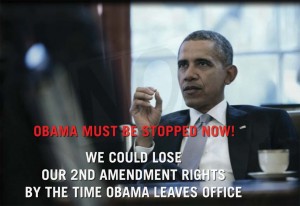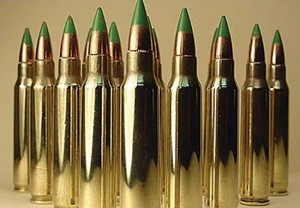by Dave Workman | Senior Editor

Still from the Second Amendment Foundation’s television campaign against the ban launched 24-hours before ATF blinked.
It was an explosive story that became something of a flash in the pan, and demonstrated that grassroots activism by gunowners is still very much a political force; the Bureau of Alcohol, Tobacco, Firearms and Explosives (ATF) proposed, but then withdrew a plan to ban one of the most popular commercial rounds for the AR-15 rifle.
As the dust settled, the Citizens Committee for the Right to Keep and Bear Arms called for ATF Director B. Todd Jones to step down or be fired.
Before that, however, the nation’s top Second Amendment groups, including the National Rifle Association, CCRKBA and the Second Amendment Foundation, fired up their memberships. The ATF received more than 80,000 comments on the proposed re-classification of the M855 round as “armor piercing.” The overwhelming majority were negative.
ATF announced the “proposed framework” on Friday the 13th in February. The idea surprised virtually everyone because leading up to it there had not been any rash of shootings involving the specific round, used in handguns. Introducing it on a Friday was suspicious because traditionally, that’s the day government agencies “drop” what might be bombshells, on the theory they hope people will forget it over the ensuing weekend.
 Not this time around. Gun activists pounced quickly, and shooting forums heated up. NRA alerted its members, and declared its opposition. Days later, CCRKBA also weighed in, and SAF general counsel Miko Tempski sent a letter to Jones detailing his group’s opposition, with the promise that if the agency adopted the ban, court action would follow.
Not this time around. Gun activists pounced quickly, and shooting forums heated up. NRA alerted its members, and declared its opposition. Days later, CCRKBA also weighed in, and SAF general counsel Miko Tempski sent a letter to Jones detailing his group’s opposition, with the promise that if the agency adopted the ban, court action would follow.
Capitol Hill was inundated with calls and e-mails, and it didn’t take long for House members to put together a letter that garnered 239 signatures – more than half of the membership including a handful of Democrats – and sent it to Jones. By the time 53 members of the US Senate signed their own letter, the writing was not merely on paper, but on the proverbial wall.
Some members suggested that the process by which ATF had unveiled the proposed framework change may have violated the Administrative Procedure Act, which sets down the procedure by which federal agencies can propose and institute regulatory changes.
Final nail
Perhaps the final coffin nail was the SAF launch of a blistering 60-second radio and television advertisement calling on people to oppose the ban and send a message to the Obama administration to back off. Twenty-four hours after that message began airing on the Fox News channel and Glenn Beck’s Blaze network, ATF announced that it was shelving the plan, at least for now.
That announcement, while constituting a victory for NRA, SAF, CCRKBA, the National Shooting Sports Foundation and activists everywhere, was also something of a warning.
The press release from the agency left gunowners suspicious that there would be more.
“Although ATF endeavored to create a proposal that reflected a good faith interpretation of the law and balanced the interests of law enforcement, industry, and sportsmen,” the agency said, “the vast majority of the comments received to date are critical of the framework, and include issues that deserve further study. Accordingly, ATF will not at this time seek to issue a final framework.”
The NSSF released a statement that the organization “looks forward to engaging in a dialogue with ATF to address this issue that led to the now withdrawn proposal.”
“Our industry members hope to meet consumer demand in bringing alternative ammunition products to the market and to continue to sell the popular M855 rifle target ammunition,” the statement said. “NSSF continues to strongly urge ATF to grant 32 long-pending petitions to exempt alternative rifle ammunition designed and intended for the hunting market.”
SAF founder and Executive Vice President Alan Gottlieb warned gunowners that the fight over Second Amendment rights is far from finished.
“We are delighted to have been a
part of the effort to stop this proposal in its tracks,” he said. “The grassroots responded to a serious threat, and the negative reaction on Capitol Hill from both the House and Senate – no doubt spurred by constituent calls and letters – have, at least for now, put the brakes on a bad idea.”
NRA officials also issued a statement cheering the decision, while being equally cautious.
“Today’s announcement proves what we have said all along — this was 100 percent political,” noted NRA Executive Vice President Wayne LaPierre.
“President Obama failed to pass gun control through Congress, so he tried to impose his political agenda through executive fiat. But every gunowner in America needs to understand Barack Obama’s hatred of the Second Amendment has not changed.”
“The lies used to justify the ban were shameful,” said Chris Cox, Executive Director of NRA-ILA. “This proposal was never about law enforcement safety – it was about the Obama Administration’s desire to pander to billionaire Michael Bloomberg and his gun control groups. Since they haven’t been able to ban America’s most popular rifle, they are trying to ban the ammunition instead.”
“This is a great victory but the battle is not over,” SAF’s Gottlieb warned.
“The Obama administration will try to rework this ban proposal and we will see it back sooner than later. Now is the time to double our efforts and drive a permanent stake through the heart of any ammo ban.”
Untimely error
But this story had one twist that raised suspicion about the ATF proposal to a fever pitch. In the middle of the controversy, it was discovered that the newest edition of their regulations had omitted a paragraph that specifically exempted M855 ammunition from classification as an armor-piercing round. That exemption had existed for several years, and its sudden absence from the new booklet caused a furor, with gunwners convinced that the ATF had “tipped its hand” and had already decided to re-classify and ban the ammunition.
Almost immediately after this new revelation hit the Internet, alarm about the proposal turned into outrage. Many in the firearms community alleged that the public comment process was only for “show.” Bloggers fanned the flames.
ATF swiftly issued a mea culpa statement that this was an editing error and insisted no such decision had been made. The agency promised that the on-line editions would restore the exemption language. But the damage was done. Any credibility the ATF may have had was gone.
This gaffe was discovered about the same time that Wisconsin Congressman James Sensenbrenner re-introduced legislation that he sponsored during the last Congress that would abolish ATF and transfer its duties to other federal agencies. Not everyone agreed with that idea, however, arguing that it might make the fight for gun rights even tougher.
‘Quit or be fired’
Within hours of the ATF announcement that it was putting the proposed ban on the shelf, at least for the time being, CCRKBA – which Gottlieb chairs – essentially declared that enough was enough. It called on Jones to step down or be fired.
“I’ve put a lot more thought into this than the ATF apparently did when it suggested that the M855 ammunition should be re-classified,” Gottlieb said in a press release. “But when Jones took over the agency, first as an acting director in 2011 and then became the permanent director in 2013, the public, and especially the Second Amendment community, had high hopes that he would straighten out the ATF. This ammunition ban blunder clearly shows that he hasn’t.”
Jones had been a US attorney, and when he came to the agency in the aftermath of the Operation Fast and Furious scandal, it was generally thought that he would bring necessary reforms, and take action against the people responsible for that gun running sting. Instead, people were allowed to retire or were simply moved to other jobs within the agency.
“Over the years,” Gottlieb said, “the BATF has earned the reputation of being a rogue agency. Anti-gunners defended the agency through the Fast and Furious scandal by blaming the lack of a permanent director. When Jones was permanently appointed, there was at least a presumption that things would change. But nobody was fired over Fast and Furious, much less prosecuted.
“Now BATF tried to ban ammunition that was specifically identified in regulations as exempt from definition as armor-piercing at the same time the exemption vanished from the regulations pamphlet,” Gottlieb said. “You cannot run a law-enforcement agency by criminalizing legal products, or by deliberately attempting to change policies that only affect law-abiding citizens.”




